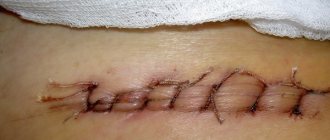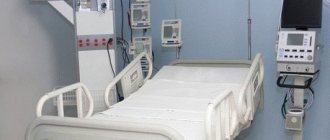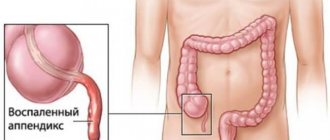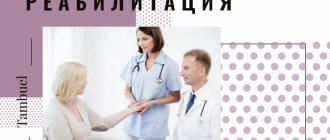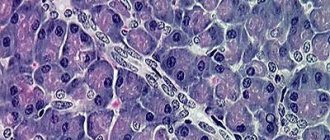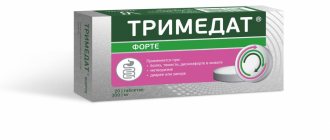The prognosis for recovery after appendectomy and restoration of the body is favorable. Already on the second day the patient is allowed to turn over in bed and even sit up. On about the third day you are allowed to get out of bed and walk.
In this regard, many patients have a question about how many days of sick leave after appendicitis and when it will be possible to return to the usual rhythm of life. The vermiform appendix becomes inflamed due to its obstruction. The lumen can be clogged by fecal drops, parasites, neoplasms, and lymphoid tissue.
This leads to the accumulation of mucus, which creates favorable conditions for the development of pathogenic microflora. The inflammatory process leads to pain in the right lower side, diarrhea, nausea and even vomiting.
Over the next few weeks after surgery to remove the appendix, it is necessary to adhere to a gentle regimen, dietary nutrition and monitor physical activity. If you ignore medical recommendations, you may encounter unpleasant complications, including inguinal hernia and adhesions.
The average patient stay after surgery is ten days. The main task of doctors when discharging a patient after an appendectomy is to make sure that the patient’s health is not in danger and that he can return to professional activity.
The duration of sick leave is directly related to the nature of the operation. The body's ability to recover is also important. In some cases, sick leave after surgery may be extended, but the law provides for regulations for this. Let's consider useful recommendations for obtaining a certificate of incapacity for work.
Removal of the appendix - what kind of operation?
The appendix is a vermiform appendage of the cecum that is involved in the process of hematopoiesis. Appendicitis is an inflammatory process that occurs in the appendix : the thin mucous membrane becomes inflamed, then the inflammatory process spreads to the appendix.
To prevent the disease from rupturing the appendix, emergency surgery (appendectomy) is prescribed. Delay threatens peritonitis, deterioration of general condition and death.
The process is removed only during surgery : laparoscopy or laparotomy. Let's take a closer look at each type of surgical intervention, how it is performed, and when it is appropriate.
Laparoscopy
Using this technique, the surgeon removes the inflamed appendage through small incisions in the abdominal wall. During the operation, surgeons use a special optical device - a laparoscope (microscopic television camera). It is inserted into the abdominal cavity and makes accurate diagnosis possible without an abdominal incision.
Laparoscopy is a more gentle method for the body to remove the appendix . Patients recover within a few days, and only 3 small and almost invisible scars (5-10 mm) remain on the abdomen at the puncture sites.
Laparotomy (abdominal surgery)
If complications arise, for example, the appendix ruptures or inflammation spreads to nearby tissues, laparoscopy is not enough. This type of intervention can be performed, but only for diagnostic purposes.
To remove the inflamed appendix and clean the abdominal cavity, surgeons resort to laparotomy . This is an abdominal operation in which the abdominal cavity is dissected.
The length of the incision is 5-10 cm. After abdominal surgery, recovery takes longer; the high temperature can last from 5 to 7 days.
Interaction with the Social Insurance Fund - innovations for 2022
From January 1, 2022, only electronic sick leave is the basis for the payment of benefits from the Social Insurance Fund. That is why employers should take care to ensure electronic interaction with the fund. This can be done in several ways:
- through the policyholder’s personal account on the FSS website, having previously registered on the State Services portal;
- through the free automated workplace program “Preparation of calculations for the Social Insurance Fund”, which can be downloaded from the Social Insurance Fund website;
- using accounting programs, including paid ones, which provide the opportunity to work with electronic sick leave;
- using the electronic interaction service “Social Electronic Document Management” (SEDO).
The first three methods were familiar to employers before, but the last one is completely new: the service is being tested this year. And if previously the electronic sick leave number was provided by the employee himself, then from the new year, with the help of the EDMS, information can be obtained without the employee; there is no need to require an electronic sick leave number from him. In the next section, we will look at how, from January 1, 2022, electronic sick leave will reach the policyholder.
Recovery period
Depending on how exactly the operation was performed, recovery can last from 2 days to 2 weeks. During laparoscopic surgery, patients are discharged on the 2-3rd day, and after laparotomy - on the 10th day .
If complications arise (hernia, peritonitis, inflammation of the suture, low-grade fever, abscess), the duration of hospital stay increases.
ATTENTION! To speed up discharge and avoid complications, the patient needs to adhere to all medical instructions, follow a regimen and eat certain foods.
Regime and diet
After removal of the appendix, patients are recommended to start walking (always in a bandage) within 5-6 hours after the operation. A little physical activity promotes rapid recovery of the body and prevents the formation of adhesions.
Heavy physical activity and lifting loads are strictly contraindicated for up to 3 months, as all this can lead to the suture coming apart or a hernia occurring.
Patients are advised to sleep at least 8 hours a day, not drink alcohol for 3-4 weeks, and lead as healthy a lifestyle as possible. The same applies to nutrition: it should be light, balanced and of high quality.
In the first 12 hours after surgery, when the body recovers from anesthesia, you should not eat . In the first 3 days, meals are very gentle, light and frequent: at least 5-6 times a day. It can be:
- chicken broths (with a small amount of fat, for example, from chicken breast);
- chicken meat: only boiled and pureed;
- vegetable purees: from potatoes, pumpkin, zucchini;
- dairy products: low-fat and sugar-free (kefir and yogurt);
- boiled rice in water.
A week after the operation, slimy porridge with water, liquid unleavened soups without salt, pureed vegetable soups, a small amount of fresh herbs, boiled carrots, dried fruits, and baked apples can be introduced into the diet.
Gradually, the menu is expanding, and more products can be introduced into it, but it is better to avoid fatty, spicy and salty dishes in principle.
ADVICE! In addition to nutrition, pay attention to water. The more you drink, the better it is for the body: all toxins are more actively removed from it, it is cleansed and restored faster.
Water can be supplemented with herbal teas, fresh natural juices and sugar-free compotes. You need to drink 1.5-2 liters per day .
Temperature after intervention
After surgery, an increase in temperature is normal. A focus of inflammation occurs in the body, and the immune system is actively involved in its work. During this, the temperature rises to 37-38 degrees and lasts from 2 to 10 days.
After laparoscopy, the temperature goes away naturally on the 2-3rd day, and after laparotomy it can last up to 10 days . Sometimes the temperature can last for 3-6 months. The reason for this may be a violation of thermoregulation or other complications.
In such cases, treatment is carried out with antibacterial drugs, anti-inflammatory therapy is prescribed, or treated symptomatically with antipyretics. It all depends on the cause, which is determined by the doctor.
When are stitches usually removed?
The abdominal wall is sutured with absorbable threads, and the skin with strong silk or synthetic threads. If wound healing proceeds without complications and the wound is covered with a crust, the sutures are removed within 7-10 days.
For what period are the newsletters provided?
The rules for issuing sick leave are regulated by Article No. 183 of the Labor Code of the Russian Federation, orders of the Ministry of Health and Social Development of the Russian Federation No. 624n dated June 29, 2011 and No. 31n dated January 21, 2012. It is issued for a period of 5 to 15 days , depending on the how the appendectomy was performed.
Who takes sick leave? The sick leave is opened by the attending physician. It is issued only at the medical institution where the treatment took place.- When is it issued? A sick leave certificate is issued upon discharge of the patient from the hospital.
Time off from work
The duration of the rehabilitation period, which is prescribed on the sick leave and frees the patient from work, depends on the patient’s condition and on the method by which the operation was performed:
- with laparotomy it is 5-7 days;
- with laparoscopy – 10-15 days;
- for complications during surgery or the postoperative period – up to 30 days.
How to renew?
To request an extension of the terms specified on the sick leave, you need:
- contact the head doctor of the hospital or your attending physician;
- come on your own or wait for a medical commission to conduct an examination;
- the certificate of incapacity for work is updated depending on what decision the commission makes.
Only the attending physician or medical commission who work in the institution where the patient was operated on and treated has the right to extend sick leave. Independent amendments to the sick leave certificate are unacceptable ; such a document is considered invalid.
Reasons for extension
Extension of sick leave is possible only in case of complications that appeared during surgery or during the rehabilitation period: diffuse or local peritonitis, rupture of the appendix, thrombophlebitis, appendiceal infiltrate (appearance of fluid).
If the patient is diagnosed with such complications, he continues to be treated in the hospital.
Depending on what decision is made by the doctors after the service, sick leave may be extended for up to 30 days . In particularly severe cases, this can be several months.
REFERENCE! The maximum period for which sick leave can be extended is 12 months.
Grounds for extending a certificate of incapacity for work
If two weeks are not enough for recovery, the period of forced leave is increased.
You can count on 30 days of sick leave if postoperative complications arise, these include:
- hernia, serious adhesions, etc. As a rule, in such situations there is a need for repeated surgery;
- abscess. With such a complication, a course of antibiotics and special physiotherapy are needed;
- pylephlebitis is a serious pathology that can lead to death. Requires complex treatment;
- purulent peritonitis;
- inflammation and bleeding at the suture site.
Dear readers! To solve your problem right now, get a free consultation
— contact the on-duty lawyer in the online chat on the right or call:
+7
— Moscow and region.
+7
— St. Petersburg and region.
8
- Other regions of the Russian Federation
You will not need to waste your time and nerves
- an experienced lawyer will take care of solving all your problems!
Decor
The registration is handled by the doctor and the patient’s employer. The doctor prescribes a diagnosis and indicates the state of health. The period is prescribed using the appropriate unified code, which is indicated in the ICD - K35-38.
Codes are also indicated indicating the general cause of disability; for appendicitis it is 01 (a disease that does not allow the employee to attend the workplace).
The employee does not fill out anything on the sick leave sheet. He only needs to come to the doctor, pick up the sheet and give it to the employer.
The employer fills out information on the sick leave certificate that relates to payment calculations and information about the company. Data for the tax office must be recorded. On a sick leave certificate, the tax code is the number 2300.
Compensation
During the rehabilitation period, the patient is not required to be at the workplace and fulfill his job obligations. In this case, the employee is paid wages for all days missed, but provided that the sick leave was filled out correctly. The first three days are paid by the employer himself, and the remaining days are paid by the insurance fund.
The amount of payments is affected by the employee's length of service. Five years of experience entitles you to a sixty percent payment of the average salary. If the work experience is from five to eight years, then the payment is eighty percent. If the length of work experience is more than eight years, then the law provides for maximum 100% payments.
So, the duration of sick leave after surgery for appendectomy is influenced by the type of surgery and the presence of complications. A correctly completed form entitles you to compensation for wages.

